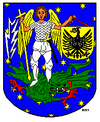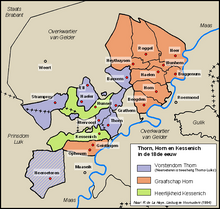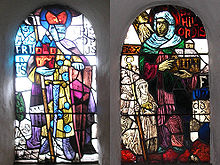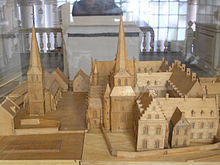Reichsstift Thorn
|
Territory in the Holy Roman Empire |
|
|---|---|
| Thorn Abbey | |
| coat of arms | |

|
|
| map | |

|
|
| Thorn Abbey (blue) in the 18th century | |
| Alternative names | Fools |
| Ruler / government | Princess Abbess |
| Today's region / s |
NL-LI , BE-VLI
|
| Reichskreis | Lower Rhine-Westphalian |
| District council | Reichsfürstenrat : 1 curiate vote on the Rhine. Prelate database |
| Capitals / residences | Thorn |
| Denomination / Religions | Roman Catholic |
| Language / n | German , Dutch |
| surface | 1.5 km² (1790) |
| Residents | 3,400 (1790) |
| Incorporated into | 1795: France 1815: Netherlands
|
The Reichsstift Thorn was in today Dutch Thorn . Created in the 10th century, it went under in 1794/1795 when it was abolished after the occupation by French troops. The monastery was imperial and belonged to the Lower Rhine-Westphalian Empire .
founding
The founding history is a bit unclear. According to some information, the facility was donated by Countess Hilswind in 902. The land required was property that the countess had previously received from King Zwentibold . The countess founded the facility for herself and her daughter Beatrix. Other information speaks of the foundation of a Benedictine double monastery by the Bishop of Utrecht Ansfried and his wife Hereswint in 925. A Romanesque abbey church was built in 992. This year is sometimes also given as the year the monastery was founded.
Pen structure

The canonesses came only from the high nobility. It is likely that Thorn belonged to the Benedictine order in the first few centuries . However, in the 12th century it finally became a free-worldly women's monastery . In any case, in 1310 the members of the monastery emphasized their quality as secular canons and claimed that they had never been Benedictine nuns.
In principle, at least in the 18th century, the canonesses were required to have residence all year round. The exception was six weeks. However, the women could buy their way out of it for 600 florins, although they had to do six weeks of choral service in each case. But this was not always observed in practice either. In addition, different women held positions in different pens. Obviously, the ladies often made use of the option of ransom. Maria Josepha von Hatzfeld und Gleichen was only a total of four years in the Essen monastery after 46 years of membership in the monastery, but never in the Thorn monastery.
There was a collegiate curia for the dean and five other houses for the ladies. In the 14th century a new Gothic abbey church was built. Some ladies had houses built outside of the monastery district.
history
The freedom of the monastery was confirmed by King Adolf von Nassau in 1292 . Under Emperor Maximilian I , the monastery was under special imperial protection. In the Wormser Reichsmatrikeln the pin was listed as imperial immediacy area. The matriculation fees were taken over by the Counts of Lippe.
The monastery belonged to the Lower Rhine-Westphalian Empire and the Rhenish Prelate College .
In the 17th century the governors of the Spanish Netherlands tried to restrict imperial immediacy. In contrast, the abbesses at the time successfully defended themselves from 1665 onwards. Since the 18th century the head women had the title of princess. Several abbesses were heads of the Essen monastery at the same time . The territory covered about 1.5 square kilometers with 3400 inhabitants in 1790.
When it was captured by French troops in 1794/1795, the monastery went under.
Abbesses
- 992-1010: Benedicta
- ~ 1020: Gerberga
- ~ 1044: Hildegardis
- ~ 1094: Godeildis
- ~ 1102: Buchardis
- ~ 1136: Aleydis
- ~ 1172: Odilia van Ubach
- ~ 1189: Elisabeth
- ~ 1217: Jutta
- 1231-1273: Hildegondis van Borne
- 1273-1304: Guda van Rennenberg
- 1304-1337: Margaretha van Petersheim
- 1337-1378: Margaretha van Heinsberg
- 1378-1387: Margaretha van Buren
- 1387-1397: Margaretha van Horne
- 1397-1446: Mechtild van Horne
- 1446-1451: Jakoba van Heinsberg
- 1451–1473: Elsa van Buren
- 1473–1486: Gertrudis van Sombreffe
- 1486–1531: Eva van Isenburg
- in addition, other women claimed leadership during this time
- 1531–1577: Margaretha IV. Van Brederode
- 1577–1579: Josina I von Manderscheid
- 1579–1604: Josina II of the Mark
- 1604–1631: Anna von der Mark
- 1631–1632: Josina Walburgis von Löwenstein-Rochefort
- 1632–1646: Anna Eleonora von Staufen (at times also Abbess of Essen)
- 1646–1647: Anna Katherina von Salm-Reiffenscheidt
- 1647–1690: Anna Salome von Manderscheid-Blankenheim (she was abbess of Essen from 1690 to 1691)
- 1690–1706: Eleonora von Löwenstein-Rochefort
- 1706–1717: Anna Juliana von Manderscheid-Blankenstein (from 1708 also Abbess von Elten )
- 1717–1776: Franziska Christine von Pfalz-Sulzbach (she was also abbess of Essen)
- 1776–1795: Maria Kunigunde of Saxony (she was also abbess of Essen)
literature
- Gerhard Taddey : Reichsstift Thorn. In the S. (Ed.): Lexicon of German history . Events, institutions, people. From the beginning to the surrender in 1945. 3rd, revised edition. Kröner, Stuttgart 1998, ISBN 3-520-81303-3 .
- Irene Crusius (Hrsg.): Studies on the Kanonissenstift. Göttingen 2001
Web links
- List of abbesses (English)


